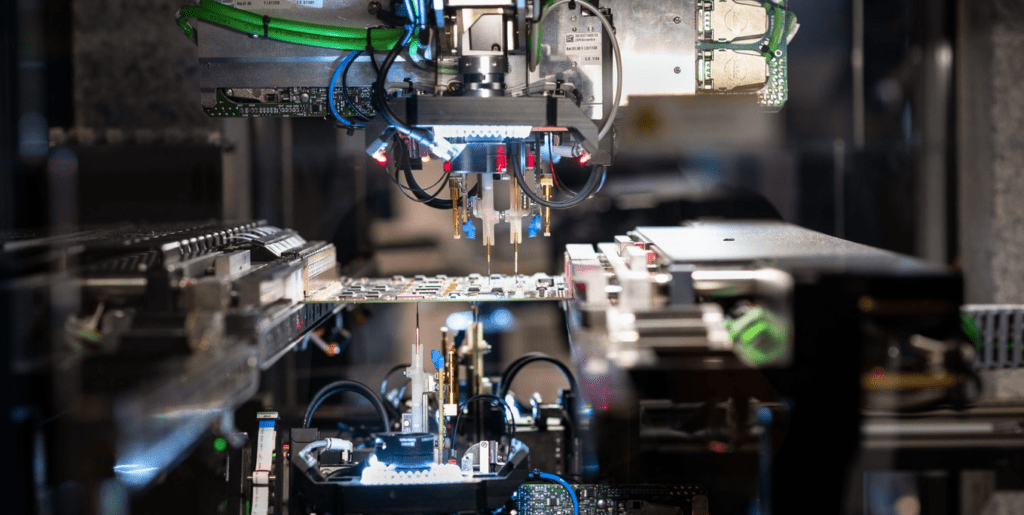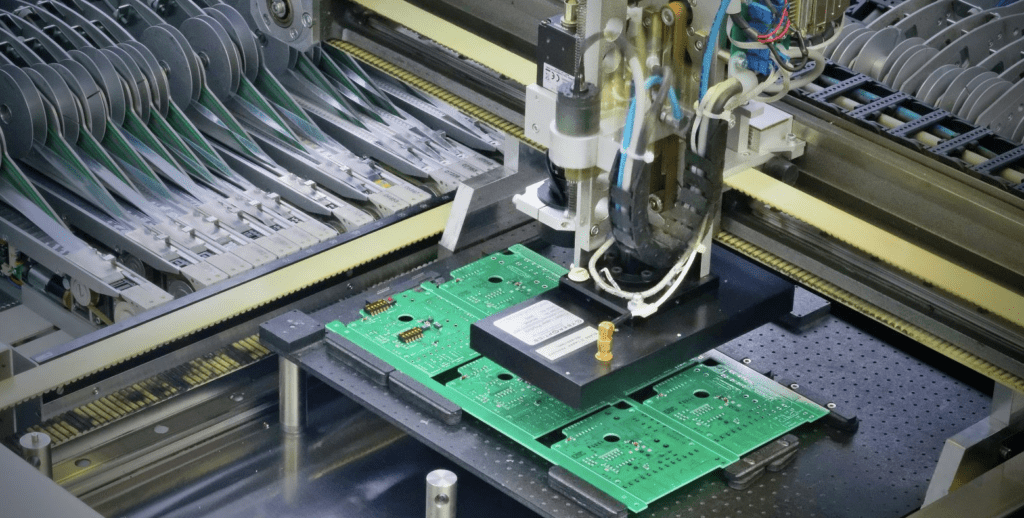These days, electronic devices comprise minute devices. Electronic device manufacturers now prefer to use SMT components. Rather than integrating traditional components that have wire leads, SMT components are now commonly used. Surface mount technology (SMT) has been the brain behind miniaturization of devices. Also, this technology has contributed to the production of complex and compact electronics.
Virtually, most of today’s electronics integrate surface mount technology (SMT). Also, SMT gained popularity in the electronics industry due to the significant advantages it offers.

What is Surface Mount Technology (SMT)?
SMT refers to the production and assembly method that involves mounting of electronic components directly on a PCB surface. Also, surface mount technology integrates automated machines to carry out PCB assembly. The electrical component mounted on the circuit board is a surface mount device (SMD). Also, SMT doesn’t require the insertion of components through holes. SMT integrates reflow soldering to solder components directly on the circuit board.
Also, this technology was initially developed and integrated by IBM to produce small-scale computers in the 1960s. Before the advent of surface mount technology (SMT), through hole technology (THT) was widely integrated. However, SMT has replaced THT in most applications since its advent. SMT components feature small tabs where manufacturers can apply solder.
THT requires the mounting components via lead holes already drilled in a circuit board. Also, these holes were specially created in such a way that the component could fit in firmly. SMT is a faster process as it doesn’t involve drilling holes. Also, SMT components are usually very minute. Therefore, they require a high level of precision when mounting them on circuit boards.
Furthermore, SMT enable the production of much smaller devices. The electronic components used in this process offer greater component density. Surface mount technology (SMT) integrates specialize tools to place tiny components on a circuit board. This process can be tedious and time consuming when carried out manually. Therefore, most SMT production is usually carried out through automation.
SMT Manufacturing Process
The SMT manufacturing process involves some crucial steps.
Material preparation
Here, the SMT manufacturer prepares all components and examines them for any defects. Apart from the components, the manufacturer also inspects the materials needed for SMT production.
Solder paste stenciling
This step is very crucial in SMT assembly process. Here, the manufacturer applies solder paste with the help of a squeegee and stencil. The solder past is usually a mixture of powdered solder and flux. Also, this flux acts as temporary glue that holds the components in place. On the other hand, the solder paste helps to connect solder pads and components on the PCB. It is important to use the appropriate amount of solder paste to coat each pad.
Component placement
This step integrates automated machine to pick and place components on the PCB surface. Also, this machine uses a vacuum to remove components from their packaging and then places it in the designated location. A high level of accuracy and precision is crucial in component placement.
Reflow soldering
Reflow soldering involves placing the printed circuit board in a reflow oven. The circuit boards passes through heat. Here, the manufacturer increases the temperature of the PCB. This is usually referred to as the preheat zone. After this, the PCB enters the soak zone where the temperature will be between 140oC and 160oC. The circuit board cools down after it has gone through heat. Reflow soldering is a very important step in SMT process.
Cleaning and inspection
After reflow soldering, the board needs cleaning to remove any dirt or debris. Also, inspection is crucial so as to detect any defect in the PCBs. Automated optical inspection (AOI), X-ray inspection, and flying probe test are example of PCB inspection methods.
Difference Between SMDs and SMT

Surface mount devices (SMDs) are components placed directly on a PCB surface. The leads of these components don’t pass through holes in the PCB like their traditional leaded component. There are three main categories of SMT devices. These are integrated circuits, transistors, and passive components.
On the other hand, SMT refers to the technology used in mounting these devices on circuit boards. Also, SMT is an assembly technique that involves the placement and soldering of electronic components on a circuit board. SMT manufacturing process needs SMDs.
Basically, the three categories of SMDs based on the package styles.
Passive components
There are various packages used for passive components. Most passive SMDs are either capacitors or resistors. The package sizes of these components are well standardized. Capacitors and resistors have different packaging sizes.
Integrated circuits
Integrated circuits have various packages. The level of interconnectivity needed determines the type of package used for ICs. Smaller chips may require small outline integrated circuit (SOIC).
Transistors and diodes
Diodes and transistors are usually in a small plastic package. The leads which come from the package create the connections. The manufacturer bends these leads to touch the PCB.
Machines Used in SMT Production
SMT process involves the integration of several machines. The main SMT equipment include:
Solder paste mixer
This machine mixes the flux and solder evenly. This ensures the solder paste mixture is perfect for solder paste printing and reflow soldering.
Reflow soldering oven
The reflow soldering oven applies heat and pressure on the printed circuit board. This oven looks like that of a pizza oven. Also, the reflow oven bakes the PCBs to get rid of any moisture. Reflow oven is a crucial machine for SMT production.
Reflow machine
The reflow machine is different from the reflow oven. Also, this machine transforms the solder from a solid state to a molten state. It melts the solder between the circuit board and surface mount components and then cools down the molten solder.
AOI machine
Automated optical inspection (AOI) machine helps to detect any error in circuit board before soldering. Also, it checks for any soldering defects. This machine performs vision inspection on the PCB. It is a versatile machine that can be used for any devices that require precision vision inspection.
The pick and place machine is very popular in SMT production. It helps in placing surface mount components on the board. Also, it is a robotic SMT assembly device that integrates a vacuum to move electronic components and place them on the PCB. This machine offers a high level of accuracy.
Solder paste printing machine
A stencil printing machine uses stencil to evenly deposit solder on the PCB. This machine cleans off any excess solder paste after applying the solder. Also, the stencil printer deposits solder paste where necessary on the PCB without any hassle.
Common Issues in with SMT Production

Manufacturers are most likely to face some challenges during surface mount technology production. It is crucial to know these issues and how to prevent them. So, what are the common challenges in SMT manufacturing?
Soldering bridging occurs when two electrical conductors that you shouldn’t connect cause electrical shorts. Electrical shorts can further cause malfunction in the circuit board. Too much solder paste can also cause solder bridging. The most common cause of solder bridging arises during solder paste printing process. Therefore, solder paste inspection is necessary.
De-wetting
De-wetting occurs when the solder doesn’t adhere well with one of the electronic components. A lengthy soaking time during reflow is one of the causes of de-wetting. Also, some solder paste materials can result in poor wettability when you placed on copper.
Tombstoning
Tombstoning is a problem that occurs when one component stands on an end. It looks like a component rising from the dead. This is why it is referred to as tombstoning. Also, this problem happens when the chip is off the board. Here, only one end of the chip is firm. One of the major causes of tombstoning is uneven distribution of heat. Due to this, one side reflow faster than the other. Another cause is differences in humidity and temperature of the solder paste.
Insufficient solder
The solder applied on the circuit board must be adequate. Insufficient solder can form fillet on the component leads. One of the major causes of this problem is when dried up paste blocks stencil aperture. You can prevent this problem by segmenting the large opening in smaller apertures and verify the squeegee pressure. Also, ensure you clean the stencil at regular intervals.
SMT Applications
SMT is a popular assembly technique in the printed circuit board industry. This assembly process is widely used in the production of some devices. Therefore, SMT is commonly integrated across industries like:
Automotive industry
Modern cars integrate electronic systems to run function well. SMT assembly line helped in the mass-production of modern cars.
Consumer electronics
The manufacturing of some consumer electronics like video game consoles, TVs, and sound systems integrated SMT. Also, SMT helped in the miniaturization of these devices. SMT PCBs are available in smartphones, laptops, cameras, etc.
The LED industry depends on SMT. LED is gradually becoming the lighting standard as a result of their durability and efficiency.
Medical devices
The medical industry is also not left out. A wide range of medical devices feature SMT circuit boards. These boards offer improved performance and reliability.
Conclusion
SMT is crucial in the printed circuit board assembly process. Integrating a complete SMT production line is crucial in electronics manufacturing. Also, the SMT process involves several steps and the use of automated machines. This article has provided insightful information on SMT production.


